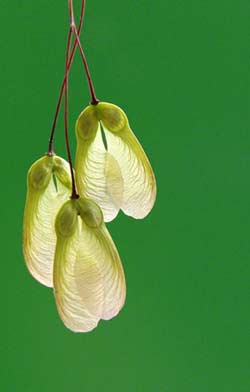Secret Found to Flight of 'Helicopter Seeds'

You probably played with them for hours — the seed pods of maple trees, slowly twirling and hovering like helicopters before falling to the ground.
The mechanism that causes "helicopter seeds" to spin has been a mystery, until now — a new study has found that the aerodynamics that keep these seeds aloft also allow certain insects, bats and hummingbirds to hover.
A team of Dutch and American scientists from Wageningen University and Caltech measured the flow of air created by swirling seeds by creating plastic models of the seeds and spinning them through a large tank of mineral oil using a specially designed robot dubbed "Robofly."
The scientists used light from a powerful laser to measure the motion of tiny glass beads in the oil as the model seed spun through the tank.
The images the team obtained showed that a swirling maple seed generates a tornado-like vortex that sits atop the front leading edge as the "helicopter" spins slowly to the ground.
This leading edge vortex lowers the air pressure over the upper surface of the maple seed, effectively sucking the wing upward to oppose gravity.
The mechanism is remarkably similar to the trick employed by insects, bats, and hummingbirds when they swing their wings back and forth to hover.
Sign up for the Live Science daily newsletter now
Get the world’s most fascinating discoveries delivered straight to your inbox.
Thus, the new study, detailed in the June 12 issue of the journal Science, shows that plants and animals have converged on an identical aerodynamic solution for improving their flight performance.
This vortex doubles the lift compared to the performance of non-swirling seeds.
To confirm the vortex finding, the scientists built a wind tunnel at the University of Wageningen in the Netherlands to examine the flow created by real maple seeds as they spin. The team used smoke to visualize the flow of air around spinning seeds, and confirmed that real seeds make a leading edge vortex which is similar in structure to that made by the flapping wings of insects, bats, and hummingbirds when they hover.
The findings could help improve technologies, such as the swirling parachutes and vehicles that have been designed by space agencies to slow down the descent of their planetary probes for exploring the atmosphere of planets such as Mars.
The research was financed by the Netherlands Organization for Scientific Research and the U.S. National Science Foundation.
- Video – Hummingbird Tales
- Many Mysteries of Flight Remain
- How Hummingbirds Hover










